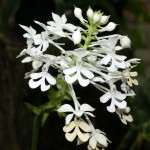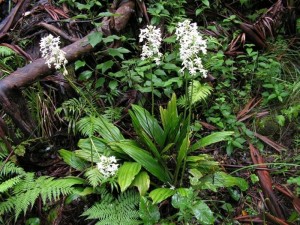Family: Orchidaceae
Synonymous: Orchis triplicata (Basionym)
Alismorkis angraeciflora
Alismorkis diploxiphion
Alismorkis furcata
Alismorkis gracillima
Alismorkis veratrifolia
Amblyglottis veratrifolia
Bletia quadrifida
Calanthe angraeciflora
Calanthe australasica
Calanthe bracteosa
Calanthe brevicolumna
Calanthe catilligera
Calanthe celebica
Calanthe comosa
Calanthe diploxiphion
Calanthe furcata
Calanthe furcata f. albolineata
Calanthe furcata f. albomarginata
Calanthe furcata f. brevicolumna
Calanthe gracillima
Calanthe matsumurana
Calanthe veratrifolia var. stenochila
Distribution and habitat: Calanthe triplicata is a species of terrestrial orchid native to Oceania, Asia and the islands of eastern Africa. This orchid is found growing in humus rich soils of rainforest shaded floors, near creeks, at elevations of 500 to 1500m (1640-4921 feet). These perennials reach heights of 40 to 100cm (16-39 inch).
The name 'Calanthe' is derivated from the Greek 'kalos' meaning beautiful and 'anthos' meaning flowers.
Description: Calanthe triplicata is an attractive evergreen, large orchid. The leaves are deep green, strongly ribbed and grow up to 50cm (20 inch) long and 15cm (6 inch) wide. Each orchid have a number of 4 to 10 leaves per shoot arising from a fleshy conical pseudobulb. It retains its leaves for several years. The nodding, spurred flowers that grow in one or two flower speaks on long, erect steams. The racemes are bearing cluster of 18 to 40 large white flowers about 5cm (2 inch) across with yellow or orange calli. The petals and sepals are narrow and equal in size, while the lip is several lobed. The characteristic features of Calanthe is the union of the column with the lip. The flowers will last 3-4 weeks. They are turning blue-black when damaged and with age. The fruit is a capsule 3-4cm (1-1.5 inch) long.
Calanthe triplicata orchid blooms from fall through winter with multiple successively opening flowers.
The list of Calanthe triplicata synonymous can be longer.
Houseplant care: Calanthe triplicata is an orchids whose cultivation conditions are very easy to follow as this orchid is not sensitive to overwatering as other orchid species. In addition, its deep green leaves are decorative when the orchid is not in bloom.
A weekly sponging of leaves is advisable for Calanthe triplicata orchids grown indoors. Remove the spent flowers and leaves as they form.
Light: Provide Calanthe triplicata with bright filtered light at all times.
Temperature: Normal room temperature should be suitable throughout the year. Ideal temperature range for the active growth period is 15-27C (59-81F) and for the rest period 10-21C (50-70F). It is an intermediate orchid grower. Ensure that a high level of humidity is retained. To do this stand the pots on trays of moist pebbles and mist-spray these orchids daily.
Good ventilation is strongly recommended to avoid rot due to high moisture levels required by these orchids, but drafts should be avoided. Do not place them near vents.
Watering: In general the rule is plentiful watering for these types of evergreen orchids, especially during the summer months. During the rest period, after flowering is finished, give them only enough water to keep the potting mixture from drying out completely.
Feeding: Calanthe triplicata orchids need regular and generous feeding, thriving on a rich compost and application of liquid fertiliser about once every two weeks during the growing season.
Potting and repotting: The potting mixture for Calanthe triplicata orchids should be a rich one, preferably incorporating peat moss and treated hardwood sawdust with some blood and bone added (about one heaped dessertspoon to a 15cm (6 inch) pot). These orchids do not need repotting every year, once every thee years will suffice. When potting Calanthe triplicata, the pseudobulbs must be half buried into the potting media.
Grow Calanthe triplicata orchids in pretty big pots 15cm (6 inch) pot) with a fairly wide base or, eventually, provide weight and stability as they grow quite tall.
Gardening:Calanthe triplicata orchids need shelter from excessive hot sun and protection from frost. They grow well as a pot plant.
Position: Calanthe triplicata will withstand direct sun but prefers shade. Place it where will receive filtered sunlight only until mid-morning, remaining in full shade for the rest of the day.
Soil: In the wild, this evergreen orchid grows best in light well - drained soils and is often found where there is an accumulation of leaf litter. Calanthe triplicata thrives in well drained but moist soils rich in organic matter and well mulched. It is best in pots planted in orchid compost.
Irrigation: Calanthe triplicatais native to climates with heavy rainfall almost all year round. Therefor these orchids species will require regular watering. As they are evergreen species, they do not really have a rest period and should be watered throughout the year as long as the temperatures are not falling below 15C (59F). This orchid can become deciduous; if water is reduced in the autumn and the plant is kept cool the leaves may drop. It will resprout in the spring. If the temperature is a bit warmer and it retains the leaves, keep it slightly moist through the winter.
Fertiliser: Feed active growing Calanthe triplicata orchids with liquid fertiliser every two weeks. Overfertilising will produce soft, lush growth at the expense of flowers.
Propagation: Propagation of Calanthe triplicata orchids is by division. Divide and repot pseudobulbs in the spring after flowering. To do this separate the older pseudobulbs from the main plant, place them in a slightly moist potting mixture and wait for the new shoots to appear from the base of the pseudobulbs.
Problems:
Calanthe plants are susceptible to spider mites, so it is important to provide ample humidity with air movement.
Treatment: Spray the infested orchids with a suitable insecticide and raise the humidity by standing the pot on a saucer of moist pebbles.
Scale insects and mealy bugs sometimes attack these plants, lurking in particular under the dried-up leaves on pseudobulbs and at the base of old flower stalks after these have been cut back.
Treatment: Physically removing the scales and then controlling the immature stages with chemical sprays may help lightly infested plants. Use an adequate pesticide to combat the insects infestation.
Slugs and snails like them so watch out.
Treatment: These pests are controlled using an appropriate molluscicide, both pellet and liquid forms, or by hand pick at regular inspections.
Note: Calanthe triplicata common name is Christmas Orchid because it is flowering during the Christmas in its southern hemisphere. So, basically they flower during the summer months. The rest period for this orchid is winter period triggered by cold weather and short daylight. If the orchids are kept in warm environment, they are evergreen orchids so watering should be not be retained.
Availability: Calanthe triplicata are very popular hobby orchid in Asia and North America.
Uses and display: Grown mainly in pots,Calanthe triplicata can also work well in sheltered, shady rock gardens - as much for its foliage as for its flowers. This orchid suits tropical, cottage and bush design gardens. It can be grown in pot or hanging basket as accent or border plant. It thrives in shadehouse conditions - so pop it on the floor. Also this orchid is suited to growing outdoors in pots or as a landscape plant in tropical and sub-tropical climates. In landscape, it needs to be plant it in semi-shaded moist situation such as under a tree.
SUMMARY:
CHARACTERISTICS:
Foliage green
Features flowers
Shape upright
Height: 40-100cm (16-39 inch)
PROPER CARE:
Watering in rest period sparingly
Watering in active growth period plentifully
Light bight filtered
Temperature in rest period min 7oC max 21oC (45-70oF)
Temperature in active growth period min 16oC max 27oC (61-81oF)
Humidity high
Hardiness zone: 10-12




